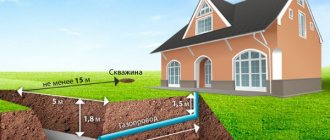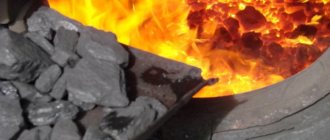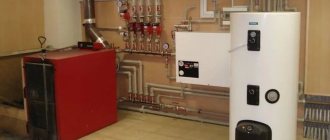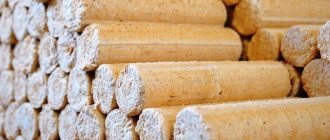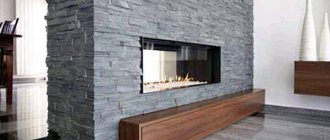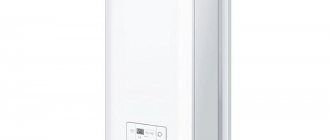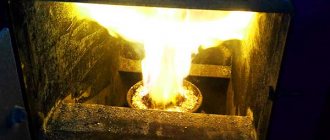Pellet heating is a modified, high-tech installation that allows fully automated operation of boiler equipment. This cannot be achieved when using coal and firewood. Pellet heating boilers have 3 main components:
- boiler with burner;
- storage tank;
- fuel supply mechanism.
Features of pellet heating
The boiler installation for burning wood pellets is considered to be the principle of space heating. Fuel is poured into tanks and supplied to the boiler furnace using automatic screw equipment. The consumption of pellets is calculated based on the heating needs of the room. The higher the need for heat, the more pellets are needed for laying.
When the required temperature is reached, the supply of pellet fuel to the firebox stops, significantly reducing material consumption. The fuel bunker can have different volumes, determining the pellet capacity from a few days to a whole year. The requirements for the heating unit must correspond to the area of the room, the main season of use, and the financial capabilities of the customer. When using pellet equipment, as a rule, an additional boiler is installed.
How to save money on heating your home
Let's figure out how to reduce fuel consumption for heating your home. First of all, you should take care of high-quality thermal insulation of the room. By insulating your house in advance with modern materials, you will be able to consume less fuel by retaining heat, preventing the penetration of cold and taking longer to cool down.
This is also affected by the quality of the windows. It is advisable to call specialists who, using modern measuring equipment, can find particularly vulnerable spots in the house and insulate them.
In second place in terms of cost efficiency is the choice of modern solid fuel (SF) equipment. The pyrolysis apparatus and long-burning boiler have increased efficiency compared to classical models. The equipment configuration also determines how much fuel burns per load and how often you will have to add flammable materials.
The frequency of solid fuel loading varies greatly over time depending on the design of the apparatus. How much can be added at a time depends on the volume of the combustion chamber.
It is also effective to install a thermostat in the room. This will eliminate excessive boiler operation. An automatic electronic system will be the most efficient way to use boiler resources, saving an additional 10-15%.
Quality of pellet granules
The characteristics of fuel pellets determine further heating, its feasibility and functionality. Pressed briquettes for this type of boiler require compliance with storage and movement conditions. When compared with the requirements for liquid and gaseous fuel materials, the situation with pellets is much simpler. It is only important to control the permissible level of humidity in the room.
The quality of pellets can be determined by burning a small number of pellets in the firebox, which will be the determining factor in purchasing a whole batch. The key point here should be quality assurance based on the combustion of experimental samples.
If it is not possible to check the granules in this way, then we offer you alternative methods:
- Visual inspection of granules. The surface of the pellets should be smooth and shiny, without obvious cracks or chips. These indicators confirm compliance with the technological process at the time of manufacturing and pressing, and natural wood was used as a binder.
- Perform a fragility test. High-quality fuel material should not crumble upon palpation, so it is best to use solid granules. Pellets with a violation of the manufacturing process will begin to crumble already at the moment of transfer by auger equipment to the furnace.
- Choose pellets packed in bags. Under such conditions of storage and transportation, fuel will not combine with dust, which negatively affects the operation of the entire heating system.
- You should buy fuel material according to the parameters, sizes and types specified in the passport of the boiler installation itself.
- Study the shade of the granules. Light-colored pellets indicate the use in production of wood materials without bark and unnecessary impurities; they are considered the most effective for heating. Dark-colored granules indicate that the manufacturer used bark and wood waste as raw materials, so their effectiveness will be significantly lower.
Factors affecting the quality and heat transfer of briquettes
The calorific value of products directly depends on their density and humidity. Products made from fine-grained raw materials with low humidity have the maximum density.
The drier the briquettes, the less heat they spend on evaporating moisture during combustion.
The humidity of the raw materials used in the production of briquettes is fundamental to the final product. The optimal humidity for products is considered to be no more than 7%. The ash content of briquettes determines how much waste will remain after their combustion. A good indicator of ash content is 0.5-1%. For straw briquettes it can range from 4 to 7.5%.
Which ones are better to choose?
Experts recommend giving preference to fuel briquettes made from dry sawdust.
Their combustion process is as close as possible to ordinary firewood. They have a low ash content and a high degree of heat transfer. The thermal conductivity of briquettes made from sawdust from deciduous and coniferous trees is approximately the same. The disadvantage of the latter is the high content of resins in their composition. When burned, they heavily pollute the chimney with soot.
The same problem arises when using briquettes made from seed husks to fire stoves. The reason they emit large amounts of soot is the large percentage of oil they contain.
When purchasing briquettes, you need to pay attention to the humidity and ash content that manufacturers indicate on the product packaging.
It must be remembered that briquettes with increased density have maximum heat transfer. Pini-kei fuel briquettes have the highest indicator. Nestros have a medium density, while RUFs have a minimum density.
How to drown them correctly
Euro firewood is ideal for heating a bathhouse. Before placing briquettes into the oven, it is well cleaned of the remnants of previous combustion. A large amount of wood chips or other flammable materials is placed on the grate. Briquettes are placed on them. They are set on fire by burning wood chips.
To heat a bathhouse, one or two stacks of fuel briquettes are enough. This is significantly less than the amount of firewood required for these purposes.
When burning, briquettes do not emit essential oils and other toxic substances that can cause human poisoning. Eurowood can be used for stoves of any type of solid fuel. One kilogram of fuel briquettes emits approximately 4.5 kcal of heat. When burning them in a stove, it is necessary to control the combustion process, as when burning ordinary firewood.
Advantages and disadvantages
The obvious advantages of this type of fuel include the following:
- no harm if stored correctly;
- adequate, stable price on the commodity market;
- use of automated equipment.
Among the shortcomings we note:
- the need for a large warehouse for winter storage;
- with the onset of the warm season, it is necessary to control the humidity in the pellet warehouse;
- the price for such a fuel installation is much higher than when purchasing electric or gas boiler structures.
How long does one briquette burn?
The briquette can burn for up to 5-8 hours, and as a rule, its burning time is set at 2-3 hours. For a stove or fireplace, longer burning is good. You can put briquettes and not add fuel until the morning, the fire will last all night. Humidity 6.6.
Interesting materials:
Is it possible to plant strawberries after peas? Is it possible to plant potatoes after strawberries? Is it possible to use superphosphate to feed strawberries? Is it possible to plant onions next to strawberries? Is it possible to plant bell peppers next to strawberries? Is it possible to plant mustard next to strawberries? Is it possible to plant potatoes next to strawberries? Is it possible to plant potatoes next to strawberries? Is it possible to plant strawberries and strawberries together? Is it possible to plant strawberries and strawberries?
Consumption and calculations of fuel pellets per 100 m²
It is worth considering that wood pellet material is a packaging product, packed in bags of a certain volume. Therefore, it is not difficult to calculate what the pellet consumption will be for 1 kW, 1 m². There is no need to interpret weight into volume, because pellet manufacturers always register goods in kg, and the unit of heat measurement is kW. High-quality fuel material has an exceptional ability to generate heat, so when burning 1 kg of wood pellets, about 5 kW of energy is generated.
Consequently, to obtain 1 kW of heat in a room, you will need to burn about 200 grams of pellets. It will not be difficult to determine the average consumption of granular fuel per 1 m², given that for every 1 m² you need 100 kW of thermal energy, subject to the permissible conditions of a ceiling height of 3 m. 100 W of thermal energy is obtained by burning 20 grams of fuel.
This calculation will be relevant if the efficiency of the pellet boiler system reaches 100%, which is not possible in reality.
The efficiency of heat generators is also indicated by higher rates, but will reach barely 85%. It turns out that when burning 1 kg of pellets in a fuel tank, no more than 4.25 kW will be released (5 × 0.85 = 4.25). You can also calculate the values the other way around. Another point is that heating 1 m² will require 100 W of heat if the ambient temperature is low enough and constant for 5 days. With average data, energy consumption for the entire heating season is almost 2 times less, which means the specific heat transfer per 1 m² is 50 W. The consumption of pellet fuel in a boiler installation for 1 hour is an incorrect calculation, and the final indicator is too small and inconvenient for calculations. It would be ideal to calculate the weight of fuel for 1 day.
Wood fuel briquette RUF
Home » Questions and Answers
WOOD FUEL BRIQUETTES – EUROWOOD
How to correctly calculate the required amount of eurowood for the heating season?
If you have been using regular firewood until now and decided to switch to fuel briquettes, then you can calculate the required supply of European firewood as follows:
Divide the previously purchased volume of regular firewood by 5 (five). The resulting number will be the required supply of briquettes in tons. In other words, 1 ton of Euro firewood replaces 5-6 m3 of ordinary firewood in terms of heat transfer.
Heating a house of 200 m2 requires 1 ton of eurowood per month.
The figures given above are approximate. The actual amount of fuel required depends on the quality of the home’s insulation, the type of stove or boiler, the efficiency of the heating system, the number of residents, the temperature conditions of the building, etc.
How to store Eurowood?
Wood fuel briquettes (euro firewood) are packed in plastic film in packs of 12 pieces weighing 10 kg. Packs of briquettes should be stored in a ventilated area where there is no open moisture. In winter, when the temperature does not cross zero, Euro-firewood can be stored outside covered with film; it is undesirable for moisture to enter in liquid form, for example, when snow melts on top of a pallet with briquettes. In summer, briquettes cannot be stored on the ground without being separated by a film from below from the fumes from the soil, because At night, moisture condenses on the packs of briquettes - in this case, on the bottom of the pallet under the packs, you need to arrange a hermetically sealed insulation from the ground, for example, with plastic film. Also, briquettes should not be stored in an unventilated, damp area, such as a basement. Briquettes leave production with a moisture content of 4-6%. If stored improperly in a damp room or if damaged packaging is openly exposed to moisture, Euro firewood will swell and lose strength. This, by the way, is an important advantage of briquettes - wet briquettes are immediately visible. Only high-quality briquettes can be durable - the increased humidity of ordinary firewood is more difficult to determine by appearance.
How many logs does 1 briquette replace?
Let's take as an example the average size of a log - length 30 cm, let's make a small assumption - let it be a log of wood with a diameter of 18 cm split into 4 parts. The volume of the log is 1908 cubic meters. cm. The density of dry aspen wood is approximately 500 kg/cubic meter, birch wood is 650 kg/cubic meter. The calorie content of any wood at 20% humidity is the same 4.16 kWh/kg. The briquette weight is 840 g, the calorific value of European firewood at 8% humidity is 4.88 kWh/kg.
1 aspen log contains - 0.001908 x 500 x 4.16 = 3.97 kWh of heat 1 birch log contains - 0.001908 x 650 x 4.16 = 5.16 kWh of heat 1 briquette contains - 0.84 x 4, 88 = 4.10 kWh heat.
Those. 1 wood fuel brique is approximately equal in heat content to 1 dried log 30 cm long.
My briquettes burn out quickly, faster than the wood I always used to heat the stove. What is the problem?
Wood briquettes - Euro firewood, compared to firewood, even dry firewood, have a much greater calorific value (briquettes are 2.2 times more caloric than undried firewood and 20% more caloric than dry firewood based on weight). When European wood is burned in the furnace and boiler firebox, a higher temperature develops due to this. And, as is known, when the temperature of the flue gases increases, the draft increases and combustion products leave the furnace more quickly. At the same time, they do not have time to transfer the heat generated during combustion to the walls of the furnace or the heat exchangers of the boiler.
In connection with the above, it is necessary to reduce the air supply to the firebox, for example, slightly cover the vent or, if air is supplied through a gap in the firebox door, reduce this hole. You can also recommend putting less eurowood in the firebox than firewood.
How many briquettes should I put in the firebox?
When switching from regular firewood to fuel briquettes, you need to be very careful. Since Euro-firewood has a much higher density and lower humidity, the amount of heat from it is 3-6 times greater than from the same volume of conventional firewood. Therefore, we recommend that you make several test fires, placing briquettes 3-6 times less in volume. In addition, different types of briquettes have different sizes and, accordingly, weight. This also needs to be taken into account. So one RUF briquette weighs approximately 0.80-0.85 kg, and a large round one weighs 2-2.5 kg. As a guide, you can use the following ratio: 1 RUF briquette (“brick”) = 1 log (8 x 30 cm, well-dried birch). If you overdo it with the number of fuel briquettes, this can cause overheating of the boiler (stove), boiling of the coolant and, as a result, deformation of the heating device itself, the chimney and the piping (if it is made of plastic pipes).
Is it possible to use Eurowood in pyrolysis boilers?
Using fuel briquettes in pyrolysis boilers is not only possible, but also highly recommended. Since one of the main requirements for fuel for a pyrolyzer is low humidity. And European firewood has a humidity of only 8-12%. Ordinary firewood, as a rule, is not even close to such indicators!
What are the disadvantages of fuel briquettes?
Compared to ordinary firewood or coal, fuel briquettes have only one drawback: you need to take a more responsible approach to the issue of storage. If you can afford to simply throw firewood in the yard in the open air, then briquettes for heating should be stored indoors or under a canopy. Fuel briquettes are afraid of direct moisture.
QUESTIONS - ANSWERS. WHAT DO WE KNOW ABOUT PELLETS?
What are pellets?
Pellets are pressed fuel granules that are made from sawdust, shavings, straw, husks and other waste from woodworking and agriculture. Wood pellets have the form of small cylinders with an average length of 10–30 mm and a diameter of 6–8 mm. High-quality pellets are environmentally friendly fuel, since the binder of the feedstock is lignin (a natural plant component), and not chemical adhesive additives.
How to store pellets?
The main condition for storing pellets is the absence of direct moisture. It is possible to store it outdoors on wooden pallets and under a canopy. Pellets can be stored indefinitely.
What is the consumption of pellets for heating?
In a house with good insulation, 6 grams per 1 sq.m. per hour i.e. per 100 sq.m. houses with good insulation 432 kg. per month; in a house with poor insulation 10 grams per 1 sq.m. per hour i.e. per 100 sq.m. houses with poorly insulated area 720 kg. per month Based on this calculation, you can calculate the approximate cost of heating.
How to take a steam bath without a broom????????
It often happens like this: you come to the bathhouse, but there is no broom. How can you take a steam bath without it? An inexperienced visitor will give up and go steaming “idle”: he will sit on the shelves and squeeze out precious drops of sweat. An inveterate lover of steaming will always find a way out. There are several ways that will somehow brighten up our “unenviable” fate. This is what I will try to write about. Imagine that an ordinary sheet would be useful for this purpose. Of course, it cannot completely replace a bath broom, but it is quite possible to get a minimal effect from steaming and improve your health in this way. So, for convenience, let’s call the person being steamed a client, and the one performing this procedure a steamer. We choose a place in the steam room so that the client can lie down freely and comfortably. Lay the sheet out on the shelf, aligning the near edge with the edge of the shelf. We assemble the opposite side and place it along the wall of the steam room. The client lies on his stomach on the sheet, positioning his body along the shelf. The steamer stands on the side of the client and covers him (except for his head) with the free part of the sheet. Grabbing the two ends of the upper part, the steamer lifts it up. The hands should perform such movements as if he were capturing the hottest steam from above. Then you need to quickly lower the sheet onto your body. Repeat this 5-8 times. After this, lower the sheet and rub the body with your hands, which will remove sweat and at the same time carry out a bath massage. It is quite enough to carry out 3-4 cycles. After this, you can roll over onto your back and hover in the same order. All! The procedure is completed. How to take a steam bath if there are no sheets It is difficult to imagine that this is even possible. But, still, anything happens in our lives. In this case, a terry bath towel from one to one and a half meters long will come to the rescue. Let's see how to use it correctly below: Fold the towel in half along its length, and then again, but this time across. Place your right hand (or left) through the folded towel. Tie a knot at your wrist. Use your palm to grab the loose ends. “device” to steam yourself like an ordinary broom and rub your body from time to time. It should be taken into account that during the steaming process the towel will absorb sweat. This will make it heavier, which will require additional physical effort. For women, this method may seem difficult, but for men it is quite possible. You can always find a way out!!!!!!!!! :))))))))))))) Bath procedures sometimes require us to be ingenious and able to use available items in order to get the greatest benefit from visiting the bath. There is no doubt that each of you will have your own techniques and ways out of situations like these. The main thing is to solve the problem of how to take a steam bath without having any bath accessories.
Continue
Which firewood is better
The wood that serves as raw material for firewood is far from identical in its properties.
Hard wood species such as birch, oak, hornbeam, beech, and yew burn hotter, have a high fibrous density, and burn more slowly.
Soft varieties have their advantages, for example: aspen produces 25% less heat than birch, but it perfectly maintains heat in a heated stove. Alder still shares a delightful aroma, as do coniferous varieties. Alder and aspen, added to the stove at the end of heating, remove soot and soot deposits in the chimney. But the formation of plaque, which can lead to clogging of the chimney, occurs during the combustion of essential oils and resins of pine, fir, and spruce. Conifers are also inferior in calorific value to birch and oak, but they dry out faster and are more suitable for kindling. Only fir sparks strongly, and larch emits a lot of carbon monoxide at the end of combustion and you need to be more careful with the damper.
Some types of fruit trees are classified as medium-hard wood and their calorific value is average. They burn, emitting an aroma, and are easy to prepare, since the wood can be split without much effort.
How to properly heat a solid fuel boiler
The process of operating the device consists of the following stages:
- Pre-ignition. On the grate you need to make a small fire from paper and wood chips. You can use other materials: branches, birch bark, sawdust. Place large logs on top and set fire. To ensure air circulation, do not place the components of the fire too tightly together.
- Primary bookmark. It is made on the coals of a fire, in a small portion, about 1-2 handfuls from both hands. The smaller the fuel fraction, the faster the combustion will occur. Then you need to periodically stir the pieces of coal for high-quality ignition.
- When the first batch of fuel flares up, you can add the next one. Now you can take larger pieces.
Next, you need to monitor the boiler and add fuel as necessary. According to the instructions, it is clear that in addition to coal, other materials are involved in the process of igniting the unit. Therefore, owners need to stock up on firewood and wood chips based on seasonal needs. It is better to store them under a canopy or in another room to keep them dry.
